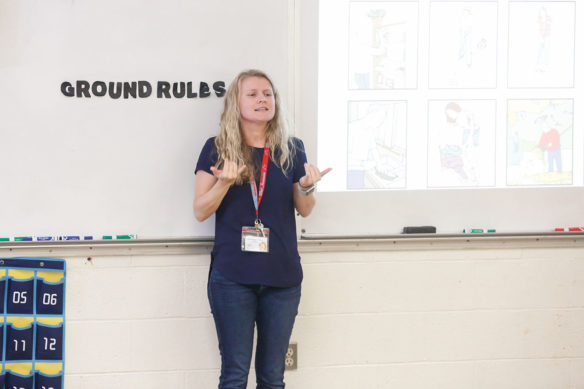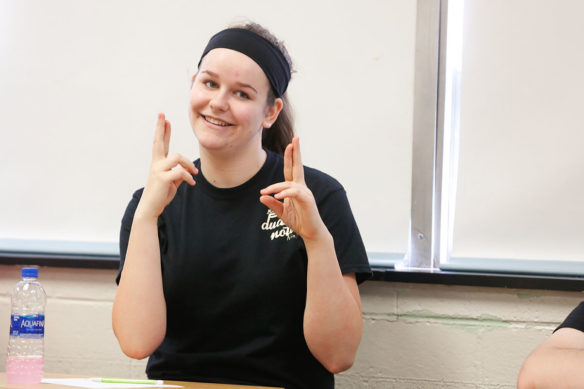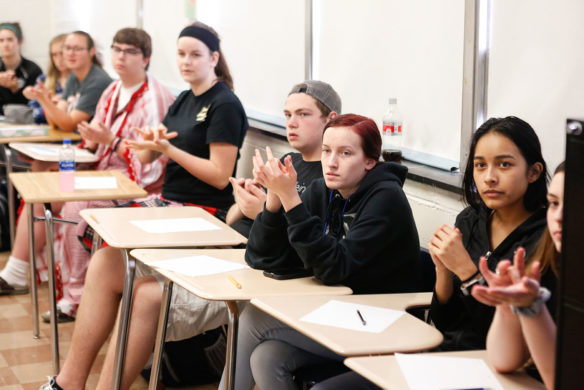
Samantha Fowler makes a point using American Sign Language (ASL) during one of the two ASL classes at West Jessamine High School (Jessamine County). Her students didn’t know until the first day of school that their teacher would be deaf and that they would effectively be immersed in ASL after one day of class.
Photo by Mike Marsee, May 10, 2019
- West Jessamine High School hired a deaf teacher for the two courses, which effectively became immersion classes.
- Students learned about Deaf culture while they learned ASL, and some are interested in a career as interpreters.
By Mike Marsee
mike.marsee@education.ky.gov
Samantha Fowler may have the quietest classes at West Jessamine High School, but what is taking place in her room speaks volumes about what teachers, students and even schools can do outside of their comfort zones.
Fowler teaches two American Sign Language classes that were introduced this year at West Jessamine High School (Jessamine County). Because she is deaf, students almost never use their voices during class, even though almost none of them could communicate with her when the school year began.
Those students are learning a recognized world language, and West Jessamine might well be the only high school in Kentucky where ASL classes can be counted as a world language credit. Fowler said she’s excited to be a part of it.
“French and Spanish are great, but in America you have the opportunity to use American Sign Language every day,” Fowler said through an interpreter. “There is already ASL instruction in many college and universities, but in Kentucky, honestly, there’s not that much there in high schools.”
West Jessamine’s classes – ASL I and ASL II – were created at the request of students. The school requires two world language credits for graduation. Marci Smith, West Jessamine’s curriculum resource administrator, said ASL might be a better fit for some students than a traditional foreign language class because it is learned largely through movement.
“For some kids, this actually gives them an opportunity to learn a language that’s going to fit them better,” she said. “This could lead to kids literally making career decisions based on this class.”
In fact, some students are considering a career as an interpreter because of their exposure to ASL and Deaf culture in Fowler’s classes.

Ysabel Jacobson, a student in an American Sign Language class at West Jessamine High School (Jessamine County), communicates with teacher Samantha Fowler using ASL. Jacobson said she has enjoyed learning about Deaf culture as well as learning ASL, and she said she would like to become an interpreter.
Photo by Mike Marsee, May 10, 2019
“I had no idea I could learn that much,” said Matilyn Jones, a sophomore who helped lead the drive to create the class. “I’ve been opened up to an entirely new career pathway. I’m looking at doing interpreting as a job now.”
Junior Ysabel Jacobson, another student who said she would like to become an interpreter, said she appreciates having been able to learn about Deaf culture as well as ASL.
“I really love the culture and the people I’ve met through Miss Fowler,” Jacobson said. “It’s a visual language and it’s really interesting. I really appreciate the culture and I’d love to be immersed in it.”
Students were immersed in American Sign Language from the first day of class, although they didn’t know that was going to be the case. In fact, they didn’t know until the first day of school who their teacher would be or that she is deaf. An interpreter was present for day one, but after that they were thrown into the deep end.
“I remember three girls cried. They didn’t know how to communicate and everyone was so nervous,” Jones said. “She signed very, very slowly, and she ended up having to write everything she said on the board for about two weeks.”
“I tried to make it easy communicating with them. I told them I’m very flexible, very accommodating,” said Fowler, a part-time teacher who had graduated from Eastern Kentucky University only three months before she started teaching. “It was important for them to practice in the beginning the alphabet, to learn their names.
“They were awkward in the beginning. Sometimes I would try to get their attention to get them to look at me. They just weren’t used to this. Finally after about two weeks they seemed to settle in. I tried to emphasize to them every day to turn off their voice, to not use their voice, because they just need more practice.”
Smith said it had not been West Jessamine’s intention to hire a deaf teacher, but she’s happy that it worked out that way.
“Once the deaf teachers started applying, it immediately became apparent that would be ideal,” she said. “One thing I love about having a deaf teacher is that when kids get to see people that are different from them, the more they can see that we’re all just people and we all have differences and we deal with those differences. That is one of my favorite things about having her in this building.”
Getting that teacher hired was not easy, however. The school reached out to Kentucky School for the Deaf and to Eastern Kentucky University, home to the deaf studies program in which Fowler studied, for help in filling the part-time position.
“The hardest part truly is finding that teacher,” Smith said. “We worked on that for months, and it was worth every second of it. It’s a great class. It’s something the kids are using immediately.”
Fowler learned about the job just before the closing date.
“Five minutes later, it seemed, I got hired. It was all within the same day,” she said.
That was on Aug. 1, and school started Aug. 15. Fowler needed a curriculum quickly and she needed advice from some of the ASL instructors she knew at the collegiate level. They steered her toward the Signing Naturally Curriculum, and she borrowed resources from EKU to teach it.
Smith said the biggest hurdle for other schools that might like to add ASL classes could be the Praxis test that teachers must pass to earn certification, because the test requires language skills that people who communicate primarily in ASL typically don’t possess.
“As a state, if we want go this route and offer this, we’re going to have to figure out ways where our deaf teachers don’t have to worry about, ‘Oh, I can’t pass the Praxis. I can’t do this.’ That should not be the thing that stops us,” Smith said.
Todd Davis, director of the Division of Educator Licensure and Quality at the Kentucky Department of Education (KDE), said the idea of a deaf or hard of hearing teacher instructing hearing students presents a new challenge when it comes to teacher preparation, and he said KDE is working to meet that challenge.
“We want to celebrate this creative learning opportunity,” Davis said. “It has uncovered some challenges, because this scenario is very different.
“We’re trying to discuss with other states what they’re doing around this. We’re digging deep into our regulations, studying those and trying to create flexibility wherever possible, but at the same time we don’t want to lose the integrity of the teaching profession. We’re trying to chart out a path to create an opportunity when those barriers are there.”

A group of students communicates using American Sign Language (ASL) in a class at West Jessamine High School. The school offers two ASL classes that can be used to fulfill a world language requirement.
Photo by Mike Marsee, May 10, 2019
Smith said the first step West Jessamine officials took when approached about offering the class was to gauge student interest, and there was plenty of that.
“We could have offered a full schedule,” she said.
The first two interested students, Jones and friend Olivia Wright, began their mission to create the courses as a combination of a service project and a personal quest. Jones’ father has lost most of his hearing and she is trying to convince him to communicate in sign language.
Jones and Wright began their work within their school’s FCCLA (Family, Career and Consumer Leaders of America) chapter. They had to make their case to three principals or acting principals along the way.
“It took an entire school year to get everything approved and all the groundwork laid,” Jones said.
Jacobson said she took the class initially to be able to communicate with a deaf classmate, and she said she now sees the value in learning ASL.
“I feel like I’m kind of almost semi-fluent,” she said. “I love the language. It’s a visual language and it’s really interesting.
“I’m very excited for this class every day. I have a lot of hard classes this year and this is one of my favorite places.”
“The more we offer kids things they like, it gives them a reason to be here, it gives them a reason to care about their classes and it gives them something that affects them in their future,” Smith said.
Fowler said she began the classes in August by introducing herself and showing the students her sign name, which is an important part of Deaf culture. She also stressed the importance of eye contact to students whose attention often takes their eyes away from their teachers.
“That does take practice, because they’re used to using their ears all the time, and in this classroom it’s the opposite. I need to see them, they need to see me and we have to practice that,” she said.
The students moved ahead to learning basics such as numbers and colors, then built on that knowledge.
“It’s not something you can just teach, it’s something you have to experience firsthand, and from that they’ll gain understanding,” Fowler said. “I told them the best way to learn it is to get out there and do it, so they can see it.”
Some of Fowler’s students have come to realize that through interactions with deaf and hard of hearing people in the community. For example, a couple of them work in restaurants or coffee shops where they have been able to communicate with deaf customers, and another used ASL to communicate with an autistic child.
Fowler requires out-of-class immersion experiences as part of the curriculum.
“They think ASL is easy, but it does take a lot of practice to embody a lot of the features of the language,” she said. “I was 2 years old when I started learning ASL. I practiced the language daily and it builds over time. It’s the same concept in here, it builds as they go.”
ASL I and II will be offered again in the coming school year. Smith said the school’s goal is to expand and to give the students a chance to put their ASL skills to use.
“We’re hoping to have some of our seniors sign at graduation,” she said. “We’re hoping to get all the way through ASL IV, and we’d like to start using students to sign as musicals and plays and presentations. We want to start incorporating them into the things we do.”
MORE INFO …
Samantha Fowler samantha.fowler@jessamine.kyschools.us
Marci Smith marci.smith@jessamine.kyschools.us




Matilyn Jones so very proud of your efforts to get ASL taught at West Jessamine High!
This is awesome!! I have two deaf uncles and a deaf aunt. … Growing up my 34-year-old daughter said that’s what I’m gonna do when I get older…
She attended UL, which offered that degree from EKU. She is nationally certified and has a passion about ASL !
We were thrilled that our daughter was able to complete both sections of Ms Fowler’s class. Our whole family benefitted from this opportunity, since we often practiced signing together as a family while we ate dinner. Our daughter hopes to further her ASL studies at U of L in the fall. Thank you, Ms Fowler, Marci Smith, and West High, for this incredible opportunity!
Congrats on your first year! So very proud of you ❤️ Your 1st/2nd grade teacher, Mrs. Cundiff (now Mrs. Sztanya)